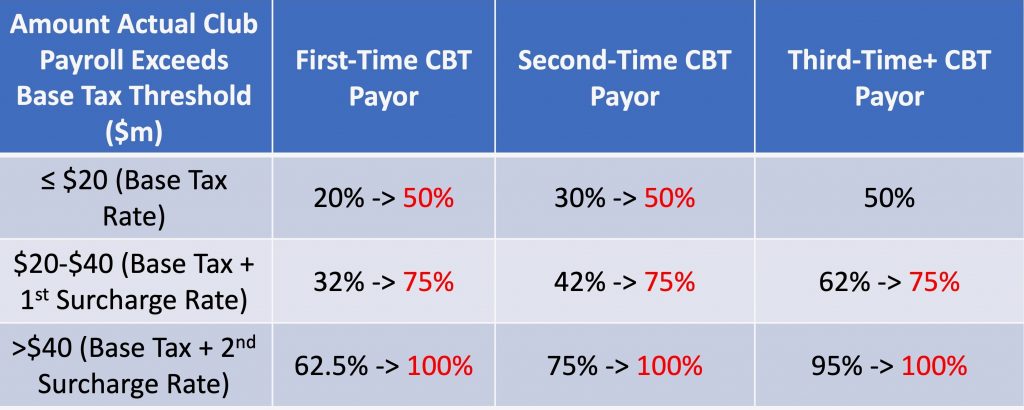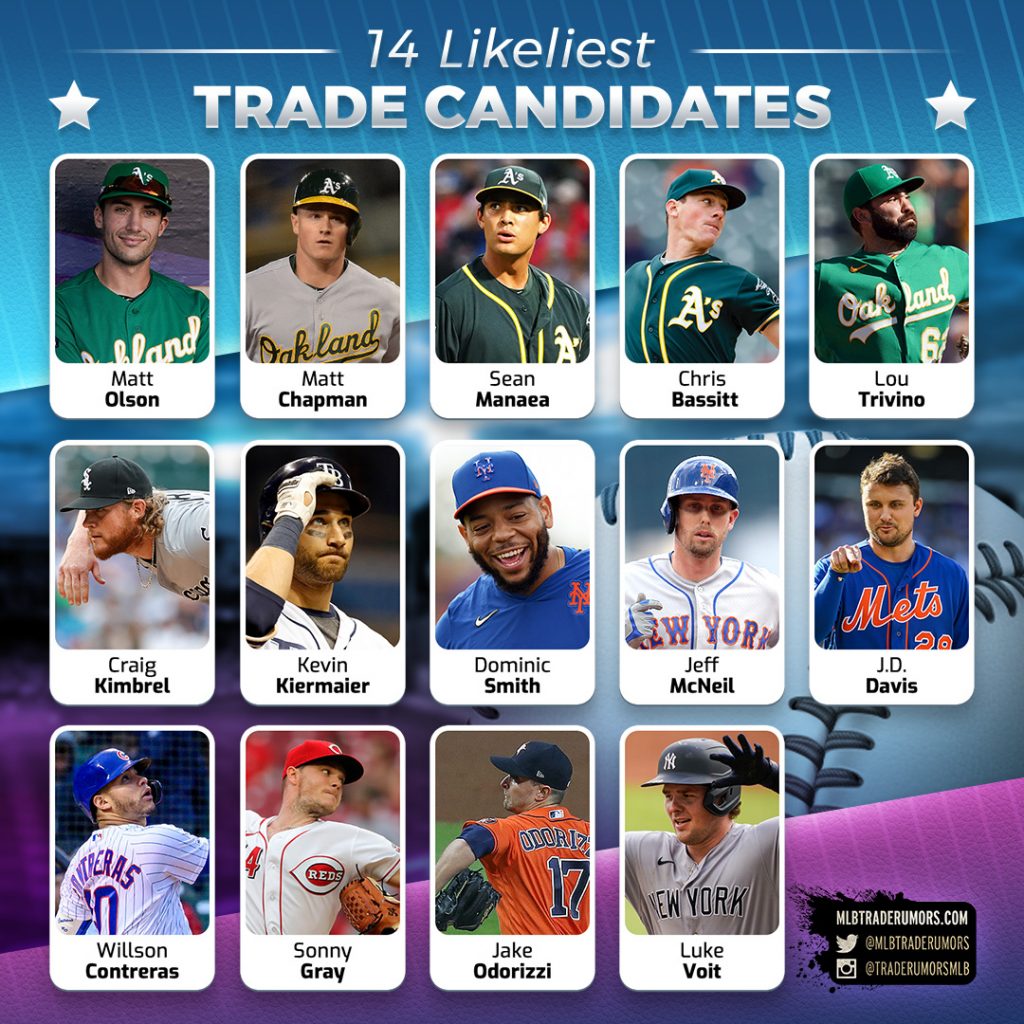In its most recent proposal, the Major League Baseball Players Association asked that 80% of players with at least two years of MLB service be considered arbitration eligible. This is up from 22%, which has been the cutoff since 2013 when it was increased from 17%. In the ongoing CBA negotiations, MLB has shown no interest in any change to the 22% figure. The MLBPA started these CBA talks at a position of making all 2+ players eligible for arbitration, which had been the case from the inception of salary arbitration in 1973 up until 1985.
I thought it might be interesting to attempt to quantify the MLBPA’s request. First, we should get an idea of how many additional players would be thrown into the arbitration system each year. As I mentioned on Twitter last week, the 80% request, if in effect this offseason, would mean changing the current Super Two cutoff from 2.116 (two years and 116 days of MLB service) to 2.028. Keep in mind that the Super Two cutoff is always a moving target.
By my count, under the 2.116 cutoff, 26 players currently qualify as Super Two this offseason, led by Vladimir Guerrero Jr., Austin Riley, and Bryan Reynolds.
Under a cutoff reduced to 2.028, 79 additional players would qualify as arbitration eligible. I’ve listed them below along with projected arbitration salaries from Matt Swartz. Note that our arbitration projection model sometimes spits out a number below the league minimum, in which case we set the projection equal to the minimum. For this exercise, we’ll use a minimum salary of $700K.
- Yordan Alvarez, Astros – $4.6MM
- Bo Bichette, Blue Jays – $4.6MM
- Will Smith, Dodgers – $3.8MM
- Kyle Tucker, Astros – $3.6MM
- Cedric Mullins, Orioles – $3.4MM
- Tommy Edman, Cardinals – $3.3MM
- Ty France, Mariners – $3.1MM
- Dylan Cease, White Sox – $3MM
- Tyler Rogers, Giants – $3MM
- Logan Webb, Giants – $2.9MM
- Zach Plesac, Guardians – $2.7MM
- Aaron Civale, Guardians – $2.6MM
- Jordan Romano, Blue Jays – $2.5MM
- Austin Hays, Orioles – $2.4MM
- Zac Gallen, Diamondbacks – $2.3MM
- Trent Grisham, Padres – $2.3MM
- Jose Urquidy, Astros – $2.2MM
- Sean Murphy, Athletics – $2.1MM
- Myles Straw, Guardians – $2MM
- Austin Gomber, Rockies – $2MM
- Nick Solak, Rangers – $2MM
- Gregory Soto, Tigers – $1.9MM
- Ranger Suarez, Phillies – $1.8MM
- Brendan Rodgers, Rockies – $1.8MM
- Alec Mills, Cubs – $1.7MM
- Nestor Cortes, Yankees – $1.7MM
- Touki Toussaint, Braves – $1.7MM
- Dustin May, Dodgers – $1.7MM
- LaMonte Wade, Giants – $1.7MM
- Austin Nola, Padres – $1.6MM
- Devin Williams, Brewers – $1.6MM
- Jaime Barria, Angels – $1.6MM
- Josh Staumont, Royals – $1.5MM
- Genesis Cabrera, Cardinals – $1.5MM
- Keston Hiura, Brewers – $1.5MM
- Griffin Canning, Angels – $1.4MM
- DJ Stewart, Orioles – $1.4MM
- Tyler Alexander, Tigers – $1.4MM
- Michael Kopech, White Sox – $1.4MM
- Cole Sulser, Orioles – $1.4MM
- Matt Beaty, Dodgers – $1.3MM
- Kolby Allard, Rangers – $1.3MM
- Pete Fairbanks, Rays – $1.3MM
- Oscar Mercado, Guardians – $1.3MM
- Steven Duggar, Giants – $1.2MM
- JT Chargois, Rays – $1.2MM
- Michael Chavis, Pirates – $1.2MM
- Jose Trevino, Rangers – $1.2MM
- Brad Wieck, Cubs – $1.1MM
- Zack Littell, Giants – $1.1MM
- Josh VanMeter, Diamondbacks – $1.1MM
- Mike Brosseau, Brewers – $1.1MM
- Rowan Wick, Cubs – $1MM
- Darwinzon Hernandez, Red Sox – $1MM
- Sam Coonrod, Phillies – $1MM
- Luis Rengifo, Angels – $1MM
- Justus Sheffield, Mariners – $1MM
- Dillon Tate, Orioles – $1MM
- Jose Ruiz, White Sox – $1MM
- Ryan Helsley, Cardinals – $900K
- Erik Swanson, Mariners – $900K
- Jacob Webb, Braves – $900K
- Anthony Alford, Pirates – $900K
- Duane Underwood, Pirates – $900K
- Edwin Rios, Dodgers – $900K
- Greg Allen, Pirates – $900K
- Sam Howard, Pirates – $800K
- Dennis Santana, Rangers – $800K
- Colin Poche, Rays – $700K
- Nick Margevicius, Mariners – $700K
- Austin Davis, Red Sox – $700K
- Hoby Milner, Brewers – $700K
- Cody Stashak, Twins – $700K
- Yoan Lopez, Phillies – $700K
- Hunter Harvey, Giants – $700K
- Jonathan Hernandez, Rangers – $700K
- Tyler Beede, Giants – $700K
- Javy Guerra, Padres – $700K
- Julian Fernandez, Rockies – $700K
To calculate how much additional money MLB teams would be paying under this system in 2022, I found the difference between the projected arbitration salary, and a hypothetical $700K minimum. So, for example, Yordan Alvarez and Bo Bichette would gain the most, an additional $3.9MM each in ’22. Note that it’s possible a few star players might make more than the league minimum even as a pre-arbitration player, like when Mookie Betts was renewed for $950K in 2017, but we aren’t modeling that in.
So, for these 79 additional Super Two players under the MLBPA’s proposal, we estimate that teams would pay an additional $72.4MM in 2022.
By itself, MLB might be willing to stomach something of that nature. They’ve shown a willingness to put $15MM into a pre-arbitration bonus pool, and I assume they could be pushed up higher if the players drop their request to change Super Two eligibility.
But there’s the rub: MLB doesn’t want any additional players thrown into the arbitration system. Doing so, particularly for star players, would increase that player’s total arbitration earnings by a significant amount, and also help push up the pay scale.
To illustrate this, we asked Matt Swartz to model out a couple of players who have been through the arbitration system already.
The first is Francisco Lindor. Lindor went through arbitration three times, earning salaries of $10.55MM in 2019, $17.5MM in 2020, and $22.3MM in 2021, for a total of $50.35MM. Under the MLBPA’s proposal, Lindor would have been arbitration eligible four times. This means he would have earned a lot more than the $623,200 he did in 2018 – 10.7 times as much, in our estimation. Here’s how our model saw a Lindor who went to arbitration four times, keeping his actual statistics the same:
- 2018: $623,200 -> $6.7MM
- 2019: $10.55MM -> $14.9MM
- 2020: $17.5MM -> $20.7MM
- 2021: $22.3MM -> $23.4MM
- Total: $50,973,200 -> $65.7MM
- Difference: $14,726,800
Our other example is Josh Bell. He’s also set to go through arbitration three times, earning $4.8MM in 2020, $6.35MM in 2021, and a projected $10MM in 2022 for a total of $21.15MM. Here’s how that might have played out had he gone through arbitration four times:
- 2019: $587K -> $2.8MM
- 2020: $4.8MM -> $8.1MM
- 2021: $6.35MM -> $9.6MM
- 2022: 10MM (projected) -> $13.2MM
- Total: $21,737,000 -> $33.7MM
- Difference: $11,963,000
The Pirates traded Bell in December 2020, knowing he was set to get a bump from $4.8MM to $6.35MM. MLB might argue that the Pirates would have traded Bell a year earlier if he was slated to jump from $2.8MM to $8.1MM. They might say that not only would expanding Super Two be bad for their pocketbooks, it’d be bad for “competitive balance.” I imagine the MLBPA would argue that the Pirates could have afforded Bell in either scenario.
There’s also the chance that shifting the arbitration pay scale a year earlier for a good number of players would simply result in them getting non-tendered a year earlier and hitting the free agent market. If you look at the list of 79 players above, you can be assured that many of them will not make it all the way through arbitration even if they earn the league minimum in 2022.
Looking at a player like Bell, if he was coming off a poor 2020 season and was set to earn $9.6MM instead of $6.35MM, he might have simply been non-tendered. As we’ve seen with an example like Kyle Schwarber, this is not necessarily a bad scenario for the player, since Schwarber earned more in free agency than he was projected to get in arbitration, and he’s set to parlay a strong bounceback year into a good multiyear contract.
If you wanted to model out the MLBPA’s 80% request further, you’d have to retroactively apply it to all the players who would’ve been affected and see how much money moves toward the players in that scenario. But it’d be impossible to guess who would’ve been non-tendered when, so it’s not an exact science. At any rate, we may learn this week whether MLB truly has any willingness to move off the 22% Super Two cutoff, even if it’s not to 80%.


